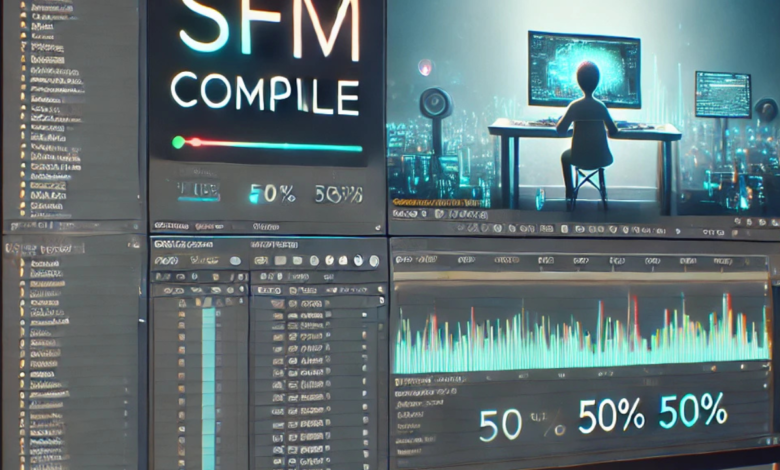SFM Compile Settings Demystified: Choosing the Best Options for Your Project”

Source Filmmaker (SFM) is a powerful tool developed by Valve that allows animators and creators to produce cinematic videos using assets from games running on the Source engine. Whether you’re working on an intricate animation or a short clip, compiling is a crucial process in SFM. It determines your rendered video’s quality, smoothness, and overall outcome. sfm compile If you’re new to SFM or struggling with compiling, this guide explains everything you need to know.
This article explains SFM compiling for beginners and experienced animators, covering everything from understanding the basics to fixing common issues and optimizing your workflow.
What is SFM Compile?
In Source Filmmaker, “compiling” refers to rendering or exporting your finished animation project into a video file. After you create and fine-tune your scenes in SFM, you must compile them into a usable format, such as MP4, AVI, or MOV. This step is essential to share your work outside of SFM.
SFM uses two primary methods for compiling:
- Image Sequence Rendering: Renders each frame as a separate image file, which can later be compiled into a video using external software.
- Direct Video Rendering: SFM compiles the animation directly into a single video file.
Both methods have pros and cons depending on your project’s needs, and understanding when to use each is vital.
How SFM Compile Works: Step-by-Step Process
The process of compiling in SFM involves multiple stages. Here’s a step-by-step breakdown:
- Setting Up Your Scene
Before compiling, ensure your scene is complete:
- Place models, lights, and cameras in the correct positions.
- Apply animations, effects, and other tweaks.
- Use the timeline to polish your animation sequence.
Make sure you review the timeline for any missing or misplaced keyframes.
- Choosing a Compilation Method
As mentioned earlier, there are two main rendering methods:
- Image Sequence Rendering is best for high-quality outputs or complex animations. You can export frames as PNG or TGA files.
- Direct Video Rendering: Faster but can produce lower-quality results.
You can find these options in SFM’s File > Export menu.
- Adjusting Render Settings
Here are key settings to configure before you compile:
- Resolution: Set the resolution of your video (e.g., 1920×1080 for Full HD).
- Frame Rate: For smoother animations, choose 30 or 60 FPS.
- Anti-Aliasing (AA): This improves video quality by smoothing edges. Higher settings increase render time.
- Motion Blur: Adds realism to fast movements. Tweak this based on your animation.
- Depth of Field (DoF): Adjust focus for cinematic effects.
- Initiating the Compile
After configuring the settings:
- Go to File > Export > Movie to render directly in video format.
- Alternatively, choose File > Export > Image Sequence to save individual frames.
- Select the output directory and file format.
- Reviewing the Output
Once the render is complete:
- Check the compiled video or image sequence for errors.
- If the animation looks choppy, revisit the project and tweak the timeline or frame rate.
- Use external tools like Adobe Premiere Pro or HandBrake for final edits or to convert image sequences into videos.

Common Issues During SFM Compile and How to Fix Them
- Compilation Freezing or Crashing
- Issue: SFM crashes during the rendering process.
- Solution: Reduce anti-aliasing, render at a lower resolution, or split the project into more minor sequences.
- Video Quality Looks Blurry
- Issue: The compiled video looks pixelated or blurry.
- Solution: Increase resolution, enable anti-aliasing, and use image sequences for higher quality.
- Slow Compilation Time
- Issue: Compiling takes too long.
- Solution: Disable unnecessary effects like motion blur or depth of field and temporarily lower the AA settings.
- Missing Frames or Corrupted Output
- Issue: Frames are missing or appear corrupted.
- Solution: Re-export the animation in smaller segments and verify file integrity.
- Audio Not Syncing with Video
- Issue: The audio doesn’t match the compiled video.
- Solution: Make sure the frame rate matches the project’s settings, and check the audio tracks in the timeline.
Tips for Optimizing the SFM Compile Process
- Use Image Sequences for High-Quality Outputs Exporting as an image sequence ensures you get the highest-quality output. This method also makes it easier to fix specific frames without re-rendering the entire animation.
- Reduce Effects for Faster Renders Effects like depth of field, motion blur, and anti-aliasing can slow the compiling process. Temporarily lower these settings for a test render.
- Split Long Animations into Segments If you’re working on lengthy animations, split them into smaller chunks. Compile each segment individually, then stitch them together in video editing software.
- Save Frequently, SFM can crash during intensive compiling. Save your project regularly to avoid losing progress.
- Upgrade Your Hardware Faster CPUs, more RAM, and a good GPU can significantly speed up rendering times.
Advanced SFM Compile Techniques
For animators looking to create professional-quality videos, here are some advanced tips:
- Custom Shaders: Custom shaders are used to enhance visual effects and textures.
- High-Resolution Outputs: Render in 4K for ultra-detailed videos.
- Post-Processing Tools: Use software like After Effects to add advanced effects, color grading, and transitions.
- Batch Rendering: Automate the rendering process for multiple projects using scripts or third-party tools.
You can take your SFM animations to the next level by mastering these techniques.
Frequently Asked Questions (FAQs)
- What is the difference between image sequence rendering and direct video rendering in SFM?
Image sequence rendering exports each frame as an individual image file (e.g., PNG, TGA), which can be combined into a video using external software. Direct video rendering compiles the animation into a single video file within SFM.
- Why does my SFM compile keep crashing?
SFM compiles may crash due to high render settings, insufficient hardware resources, or large project sizes. Try lowering anti-aliasing settings, rendering at a lower resolution, or splitting the project into smaller parts.
- How can I improve the quality of my SFM compile?
To improve quality, increase the resolution, enable anti-aliasing, and render as an image sequence instead of a direct video.
- How long does it take to compile in Source Filmmaker?
The time it takes depends on the project’s complexity, resolution, and your computer’s hardware. High-quality renders with effects like anti-aliasing and motion blur can take hours.
- Can I fix a specific frame without re-rendering the entire animation?
Yes, you can re-render individual frames when exporting as an image sequence without recompiling the entire project.
Conclusion
Understanding the SFM compile process is key to creating polished, high-quality animations in Source Filmmaker. By choosing the proper rendering method, configuring your settings, and addressing common issues, you can optimize your workflow and produce professional videos.
Whether you’re a beginner or an experienced animator, mastering SFM compiling will enhance your ability to bring creative ideas to life. You’ll achieve stunning results that impress your audience with patience and practice.
Start experimenting with SFM today, and don’t hesitate to use these tips and techniques to improve your compiling process!



